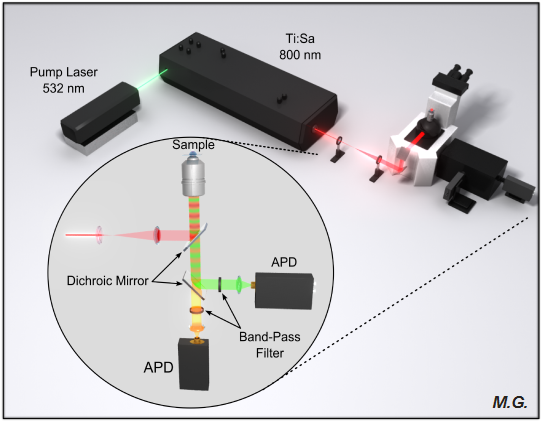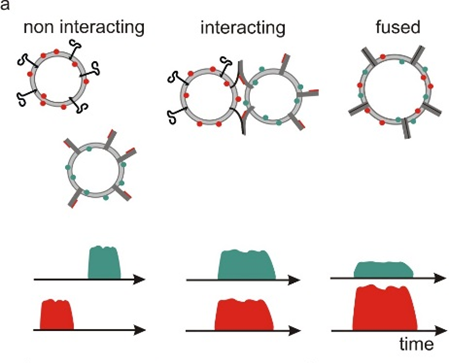Membrane fusion is pivotal in many processes like synaptic signal transmission but also membrane trafficking, viral entry or fertilization. These processes are regulated by various proteins with SNARES (soluble N-ethylmaleimide-sensitive factor attachment protein receptors) being very important catalysts for this process. However, prior to fusion important intermediate states occur that are presumably decisive for the general regulation of membrane interactions. For example, pre-docked states exist in which the membranes are tethered by certain proteins but are not yet fused. Such states might be pivotal to allow for quick triggering of the actual fusion event.

In order to investigate the mechanism by which various types of proteins regulate docking and fusion assays are necessary that are able to distinguish non-interacting membranes from docked and fused states. To this end, liposome model systems are particular useful as they allow to selectively investigate the different roles of individual key players reconstituted into two different sets of liposomes representing the two interacting membranes. Therefore, we have developed a liposome assay based on single liposome detection, two-photon two-color fluorescence cross-correlation spectroscopy and fluorescence lifetime measurements that allows to differentiate individual free, docked or fused liposomes or quantify the number of free, docked or fused liposomes in a confocal detection volume of a microscope set-up.

The assay is based on labelling the lipids of two different sets of liposomes with two different dyes. The two different sets of liposomes can contain different proteins, can have different lipid compositions and different membrane curvatures as differing diameters down to ~30 nm are possible. The two dyes can emit, for example, fluorescence in the red and green spectral range. In a two-photon excitation microscope an excitation wavelength can be selected that excites both dyes to approximately the same extend when liposomes diffuse through the excitation volume of about 200-300 nm in diameter. Non-interacting liposomes are detected as independent fluorescence signals in the red and green detector channel of the microscope set-up. If liposomes are docked or fused, the red and green fluorescence signals are detected in a correlated manner. In addition, if the liposomes are fused, Förster energy transfer occurs within the lipid bilayers leading to a reduction of the green fluorescence emission and an increase in the red fluorescence emission. In order to quantify the percentage of docked or fused liposomes diffusing through the detection volume two-photon, two-color fluorescence cross-correlation spectroscopy is applied. For robust determination of the degree of lipid mixing (fusion) in a sample, simultaneously the fluorescence lifetime of the donor molecules is recorded.

Thus, entirely non-interacting liposomes are detected by zero cross-correlation amplitudes and long donor lifetimes, corresponding to no energy transfer of fused lipid bilayers. Docked liposomes are detected by high cross-correlation amplitudes but still the donor lifetimes are long, corresponding to no energy transfer in lipid bilayers. Finally, fused liposomes are detected by high cross-correlation amplitudes and short donor lifetimes, corresponding to efficient energy transfer in the mixed lipids. In the past we have gained very important mechanistic details about the regulation of membrane fusion using this approach ([1,2,3]). Currently, we extend this approach to detecting hemi-fusion in which the outer lipid layer is already fused while the inner is not. According to theoretical calculations such hemi-fused states very likely also play a pivotal role in mechanisms regulating membrane fusion. The simultaneous detection of lipid mixing of in the inner and outer layers is done by asymmetrically labeling the inner and the outer layers with different sets of dyes ([4]). We plan to apply this approach to further elucidate the mechanisms by which important regulators govern docking, hemi-fusion and fusion govern of membranes
[1] A. Cypionka , A. Stein , J. M. Hernandez , H. Hippchen , R. Jahn , P. J. Walla "Discrimination between docking and fusion of liposomes reconstituted with neuronal SNARE-proteins using FCS", PNAS, 106, 44, 18575-18580 (2009).
[2] J. M. Hernandez, A. Stein, E. Behrmann, D. Riedel, A. Cypionka, Z. Farsi, P. J. Walla, S. Raunser and R. Jahn,"Membrane Fusion Intermediates via Directional and Full Assembly of the SNARE Complex", Science, 336, 1581-1584 (2012).
[3] W. Vennekate, S. Schröder, C.-C. Lin, G. van den Bogaart, M. Grunwald, R. Jahn, P. J. Walla,"Cis- and trans-membrane interactions of synaptotagmin-1", PNAS, 109, 11037-11042 (2012).
[4] C.-C. Lin, H.-F. Hsu, P.J. Walla, " A One Donor-Two Acceptor Lipid Bilayer FRET Assay Based on Asymmetrically Labeled Liposomes " J. Phys. Chem. B. , accepted (2016)
Arbeitsgruppen
AG Hohm
AG Jacob
AG Kozuch
AG Maul
AG Proppe
AG Tschierlei
AG Walla
Assoziierte Gruppen
AG Muñoz (GRS)
Emeriti
AG Becker
AG Gericke
Personal
Leitung
Institutsvorstand
Personalverzeichnis
Einrichtungen
Werkstatt
Schülerlabor Chemie
Agnes-Pockels-Labor
Dokumente
Institutsordnung
Betriebsanweisungen
Laserschutz
Notrufblatt
Technische Universität Braunschweig
Institut für Physikalische und Theoretische Chemie
Gaußstraße 17
38106 Braunschweig
Postfach 3329
38023 Braunschweig
Telefon 0531 3915325
